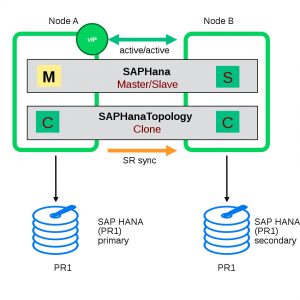SUSE powers SAP HANA system replication in AWS cloud
We did it again! SAP’s LinuxLab is an excellent place for collaboration projects. Architects from Amazon Web Services and SUSE developed a brand-new best practice available at https://www.suse.com/documentation. The new guide explains how to automate SAP HANA system replication (SR) in the AWS virtual private cloud with SUSE cluster technology. The solution is of course based leading operating system – SUSE Linux Enterprise Server for SAP Applications. The guide focuses on the performance optimized scenario which allows the fastest takeover procedure to the secondary site.
Content of the new Guide
The guide explains the architecture of the SAP HANA SR in the cloud, supported scenarios and typical prerequisites. One of the most important prerequisites covers the implementation of a reliable fencing (“Shoot The Other Node In The Head “- STONITH) method. STONITH helps the cluster to ensure that a lost cluster node is definitely not running resources (like SAP HANA) any more when the cluster decides to takeover those workloads and resources.
The setup procedure is also described step-by-step, beginning with preparing the AWS environment, then installing SAP HANA up to integrating the database into the SUSE cluster.
After the setup procedure the document discusses administrative do-and-don’t as well as points to additional external resources providing further information.
Moving a workload architecture from “on-premise” to a cloud forces some additional setup steps. Therefore the guide describes the steps needed in AWS as well as the steps to install and integrate SAP HANA into the SUSE cluster.
Configuration Steps Overview
At the begin of the setup you prepare the AWS environment. The guide explains the AWS terminology and topology such as regions, availability zones and AWS virtual private network. It describes all needed steps to prepare your AWS environment to be ready to install SAP HANA into your systems and to integrate your database into the SUSE cluster. In particular it explains the concept of the AWS virtual private cloud (VPC) as network component, the use of overlay IP addresses and routing changes. This concept allows clients to connect transparently whenever the cluster processes a takeover from one availability zone to an other.
The next main step describes the installation of SAP HANA in both AWS regions, including setting up SAP HANA system replication. NOTE: This section was added more as a reference to allow an easy setup description, but does not of course replace the original SAP installation and administration documentation. You should always read and follow the SAP documentation in addition to our procedure.
After the successful implementation of the system replication we recommend to test this functionality via manual test takeovers. This checks that everything is ready for the cluster integration.
Now it’s time to setup the SUSE cluster. The resource agents SAPHana and SAPHanaTopology are handling the SAP HANA database in both availability zones. These resource agents are exclusively part of the SLES for SAP Applications product. You can use them without paying additional fees. In this phase of the project you will install the cluster software. Then you build the base cluster configuration and add the resources controlled by the cluster. The required resources include the STONITH method, the overlay IP address and the routing entries.
Finally you integrate the already running SAP HANA system replication pair using the SAPHana* resource agents.
What’s next?
Visit our SUSE best practice library. Have a look at the document “SAP HANA High Availability Cluster for the AWS Cloud” and start you project to automate SAP HANA system replication using the SUSE cluster solution.
Related Articles
Jul 11th, 2022

No comments yet